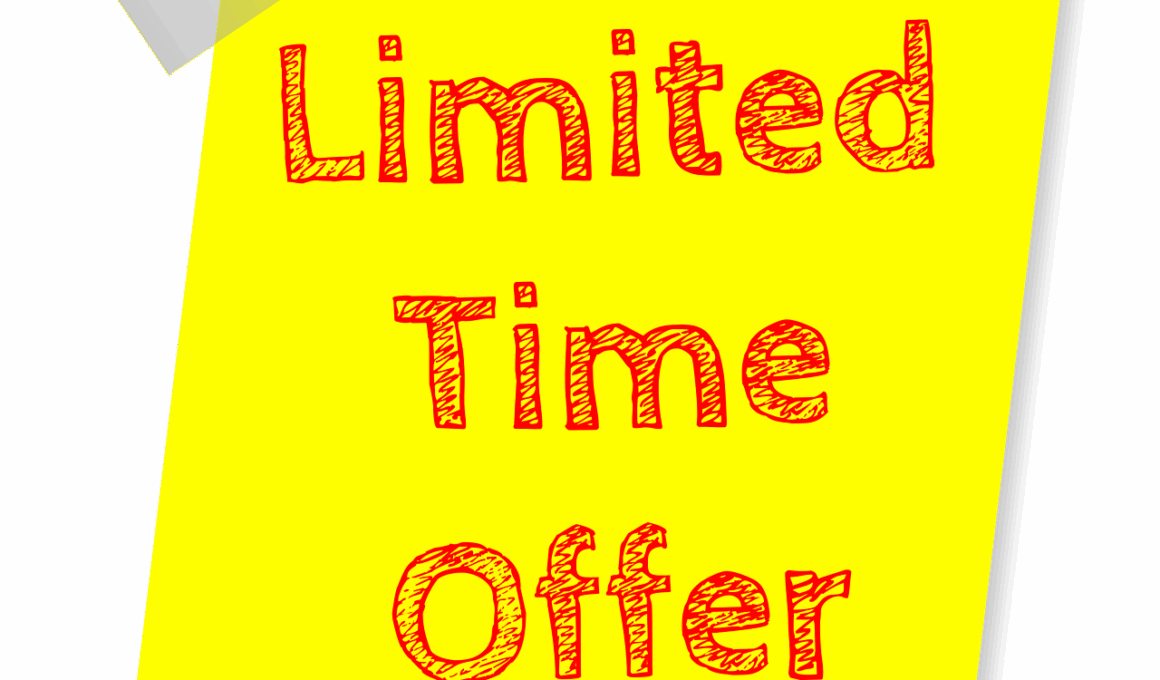Creating Limited-Time Offers to Stimulate Early Sales
Limited-time offers are an effective marketing strategy in social commerce that can create urgency and boost early sales. By setting a specific deadline, businesses can encourage potential customers to make quicker purchasing decisions. These offers work by appealing to consumers’ fear of missing out (FOMO), which is highly influential in today’s fast-paced online shopping environment. One way to create a compelling limited-time offer is by offering exclusive discounts, providing customers an irresistible deal not available otherwise. Moreover, coupled with social proof, such as showing how many products have already been sold, can further enhance the effectiveness of the offer. Regularly promoting these limited-time offers through targeted social media posts can also engage the audience more effectively. Businesses should use eye-catching visuals coupled with concise messaging to convey the deal’s value clearly. Also, using countdown timers in posts or stories can increase pressure for consumers to act fast, drawing attention and prompting immediate responses. Therefore, it’s essential that the marketing team works coherently to develop these promotions strategically, ensuring that they resonate well with the target audience, ultimately leading to higher conversion rates.
Another effective approach for creating limited-time offers is designing a sense of exclusivity around the deal. This can be achieved by offering the promotion to a select group of customers, such as email subscribers or social media followers. Engaging with a targeted customer base can create a community feel, encouraging them to share the exclusive offer with their peers. Tactics like this provide not merely a limited-time bargain but also add a conversational element that can enhance brand visibility. Furthermore, utilizing gamification elements, such as rewarding customers for sharing the offer, can amplify engagement. Customers often appreciate when they feel actively involved in the promotional process. To implement this, businesses can create referral programs or social sharing incentives, allowing customers to spread the word while receiving benefits. Additionally, incorporating user-generated content where customers showcase their purchases can significantly build trust and authenticity around the campaign. By facilitating this interaction, businesses foster a sense of belonging among customers, strengthening loyalty and encouraging future purchases. Therefore, exclusivity and gamification are essential components to enhancing the urgency and attractiveness of limited-time offers in social commerce.
Leveraging Social Media Influencers
Engaging social media influencers can exponentially increase the reach of limited-time offers. By collaborating with influencers who resonate with your target audience, businesses can tap into their established networks and credibility. Influencers create content that can showcase the offer creatively, making it more relatable to their audience. Their endorsements lend authenticity to your promotions, helping you build trust with potential customers who may be unfamiliar with your brand. When planning campaigns with influencers, it’s crucial to provide them with clear messaging and guidelines while allowing enough creative freedom. This balance ensures that they can convey your limited-time offer in a manner that resonates with their audience while sticking to your brand voice. Additionally, utilizing influencer-generated content for promotion across different channels amplifies the impact as their followers may perceive such content as organic and trustworthy. Products often witness a boost in initial sales once influencers share time-sensitive promotions through vibrant and engaging posts. Consequently, influencer partnerships can greatly enhance the overall success of limited-time offers while reaching a wider audience, thus effectively stimulating early sales through increased visibility.
To maximize the effectiveness of limited-time offers, it is essential to analyze customer behavior data beforehand. Understanding what promotions resonate well with your audience allows you to tailor these offers effectively. Using analytics tools, businesses can track consumer preferences, previous purchases, and engagement levels. This data can provide insights that enable companies to tailor their offers to better meet consumer expectations and improve satisfaction. For example, if data indicates that consumers respond better to a particular type of discount or special product feature, businesses can leverage this insight when creating limited-time offers. Moreover, segmentation of customers based on their behavior will allow marketing teams to create personalized promotions targeted to specific groups, increasing chances of conversion. Timing is another vital factor; therefore, businesses should consider when their audience is most active online and optimize their promotions accordingly. Additionally, conducting A/B tests on different promotional strategies can help determine which approach yields better results. Overall, data-driven strategies for limited-time offers ensure businesses can reach their target audience more efficiently while maximizing sales during the promotional period.
Crafting Compelling Messaging
The messaging surrounding a limited-time offer plays a critical role in its success. It should be crafted to clearly communicate the offer’s value while generating excitement among potential customers. Using powerful and persuasive language can greatly impact how the audience perceives the promotion. Create urgency with words and phrases like “limited stock,” “exclusive access” or “last chance” to motivate immediate action. Additionally, visuals should not be overlooked; using high-quality images and videos helps to grab attention, emphasizing the deal’s attractiveness. Compelling graphics can boost engagement and enhance brand recall. Businesses should also consider employing storytelling techniques in their messaging that connect emotionally with customers. This can make the offer feel more personalized and relevant. Sharing customer testimonials or success stories related to the product can further strengthen trust and entice others to respond positively. Moreover, clarity is key: ensure that the terms of the promotion are easy to understand to avoid confusion. By combining urgency, clarity, emotional engagement, and quality visuals, businesses can elevate their limited-time offers and drive more sales effectively.
After launching a limited-time offer, it is essential to monitor its performance continuously. Data analytics allow businesses to assess engagement, conversion rates, and overall effectiveness over time. By examining these metrics, companies can understand what worked well and identify areas where adjustments might be needed. Adapting based on insights is crucial in ensuring the longevity of momentum generated by the offer even after it has ended. For instance, if a particular type of promotion yielded high engagement, businesses could capitalize on that success by similarly structuring future offers. Moreover, customer feedback collected during and after the promotional period can provide valuable insights into consumer sentiment regarding the offer and product quality. Engaging with customers through follow-up surveys and social media platforms maintains a connection, nurturing customer relationships. Retargeting those who showed interest but did not purchase can also be an effective strategy. Sending tailored reminders about the offer or related products can ignite interest and prompt a purchase decision. By analyzing past promotions and optimizing future strategies, businesses can strengthen their social commerce efforts, ensuring lasting success.
Conclusion
Creating limited-time offers is a powerful technique for stimulating early sales in social commerce. By combining urgency with exclusivity, leveraging influencers, crafting compelling messaging, and utilizing customer data, businesses can uniquely enhance their promotional strategies. Each element plays a significant role in converting casual browsers into buyers and building lasting relationships with customers. It’s essential to remain adaptable and responsive to consumer preferences, ensuring that each promotional campaign resonates with the target audience. As competition in the social commerce landscape continues to intensify, incorporating these strategies effectively can help brands stand out in a crowded market. Consistently evaluating performance and employing customer feedback also contribute to optimizing future offers, reinforcing brand loyalty. Therefore, adopting a well-rounded approach to limited-time offers will undoubtedly lead to sustained growth. Companies must embrace this dynamic marketing tactic and integrate it into their overall social commerce strategy. By prioritizing both creativity and consumer understanding, businesses can successfully navigate the nuances of social commerce, ultimately achieving remarkable sales outcomes from their limited-time promotions.
In summary, successfully implementing limited-time offers requires a strategic approach tailored to meet consumer needs. Companies should place a heavy emphasis on data analysis, harnessing insights for structured decision-making when developing offers. Identifying what motivates their target audience allows businesses to hone in on aspects of exclusivity or urgency. Engaging with social media influencers can further broaden exposure while ensuring authentic connections with potential buyers. Crafting clear and compelling messaging combined with attention-grabbing visuals plays a critical role in capturing interest and driving conversions. Moreover, monitoring results post-promotion facilitates continuous improvement, empowering brands to create even more effective campaigns in the future. Lastly, maintaining customer engagement is also essential for building lasting relationships and promoting loyalty. Thus, the integration of limited-time offers within social commerce not only drives quick sales but forms a foundation for ongoing customer engagement and stronger brand loyalty. Companies that successfully navigate this approach can expect improved sales while enhancing their overall brand credibility and market presence.


